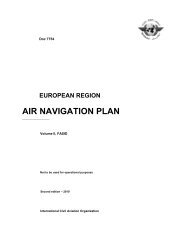7754 Vol 1 Flyleaf - ICAO Public Maps
7754 Vol 1 Flyleaf - ICAO Public Maps
7754 Vol 1 Flyleaf - ICAO Public Maps
Create successful ePaper yourself
Turn your PDF publications into a flip-book with our unique Google optimized e-Paper software.
BORPC I-11<br />
up to a distance from the aircraft corresponding to two<br />
hours’ flying time.<br />
8.3.2 The determination of the aerodromes at which<br />
landing forecasts are required should take into<br />
consideration relevant operational and climatological<br />
factors, including the weekly number of flights requiring<br />
those forecasts and the incidence of adverse<br />
meteorological conditions.<br />
8.4 Meteorological observations and reports<br />
8.4.1 Meteorological observations and reports should<br />
be made at hourly intervals. However, the intervals should<br />
be half-hourly at aerodromes where the volume of traffic<br />
and the variability of meteorological conditions so justify,<br />
and/or reports are required for data link-VOLMET or<br />
VOLMET broadcasts, and relevant OPMET bulletin<br />
exchange schemes.<br />
8.4.2 METAR and SPECI should be exchanged to<br />
meet the needs of current flight operations. METAR and<br />
SPECI for the aerodromes of departure and destination<br />
and their respective alternates, and en-route alternates<br />
should be disseminated so as to be available at departure<br />
aerodromes and at ATS units designated to provide data<br />
link-VOLMET or VOLMET broadcasts for aircraft in<br />
flight. In addition, they should be disseminated to be<br />
available at ATS units for transmission to aircraft in flight<br />
up to a distance from the aircraft corresponding to two<br />
hours' flying time.<br />
8.5 Aircraft reports and SIGMET and AIRMET<br />
information<br />
8.5.1 For international air routes having a high density<br />
of air traffic, air-reporting exemption or designation<br />
procedures should be developed to reduce the frequency<br />
of routine air-reports commensurate with the minimum<br />
requirements of meteorological offices. The procedures<br />
should be included in the Regional Supplementary<br />
Procedures (Doc 7030).<br />
8.5.2 SIGMET and AIRMET messages, as well as<br />
special air-reports which have not been used for the<br />
preparation of a SIGMET, should be disseminated to<br />
meteorological offices so as to be available at departure<br />
aerodromes for the whole route and at ATS units<br />
designated to provide data link-VOLMET or VOLMET<br />
broadcasts for aircraft in flight. In addition, they should be<br />
disseminated to be available at the ATS units for<br />
transmission to aircraft in flight for the route ahead up to a<br />
distance corresponding to two hours flying time.<br />
8.6 International Airways <strong>Vol</strong>cano Watch (IAVW)<br />
– Regional aspects<br />
8.6.1 Planning for regional aspects of the IAVW<br />
should be undertaken, including the designation of<br />
volcanic ash advisory centres (VAAC) and selected State<br />
volcano observatories.<br />
8.7 Tropical Cyclone Watch – Regional aspects<br />
8.7.1 Planning for regional aspects of the tropical<br />
cyclone watch should be undertaken for regions affected<br />
by tropical cyclones, including the designation of tropical<br />
cyclone advisory centres (TCAC) amongst the centres of<br />
the WMO Tropical Cyclone Programme.<br />
9. AERONAUTICAL INFORMATION<br />
SERVICES AND AERONAUTICAL CHARTS<br />
9.1 The designation of international NOTAM offices<br />
and their areas of responsibility should be based on<br />
maximum efficiency in the dissemination and exchange of<br />
aeronautical information/data by telecommunications and<br />
on optimum use of the aeronautical fixed service (AFS).<br />
9.2 Arrangements for the international exchange of<br />
elements of the Integrated Aeronautical Information<br />
Package and aeronautical charts should be established to<br />
meet the needs of all forms of international civil aviation.<br />
9.3 Arrangements for the transmission and exchange<br />
of NOTAMs should be planned with a view to<br />
recommending measures to ensure that adequate<br />
information is available to users in a timely manner, and<br />
that its presentation is efficient as to format and selective<br />
as to contents.<br />
9.4 The advantages of using AIS automation<br />
integrated systems should be considered when planning<br />
the exchange of aeronautical information/data.<br />
9.5 Priority for the planning and implementation of<br />
AIS aerodrome units should be based on aerodrome<br />
designation (RS, RNS, RG, AS and EAS) as set out in the<br />
ANP AOP-1 table.<br />
9.6 Pre-flight information bulletins (PIBs) should<br />
be made available at designated internationalairports at<br />
least one hour before each flight in order to meet the<br />
operational requirements of users.<br />
9.7 Planning and arrangements should be made for<br />
the introduction by States of one quality management<br />
system for aeronautical information and charts services.<br />
The system must include procedures, processes and<br />
resources necessary to ensure that the procedures are put<br />
in place in all the functional stages of aeronautical data














